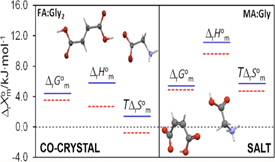
Energetics of Glycine Cocrystal or Salt Formation with Two Regioisomers: Fumaric Acid and Maleic Acid
A.O.L. Évora, C.E.S. Bernardes, M.F.M. Piedade, A.C.L. Conceição, M.E. Minas da Piedade
Cryst. Growth Des. 2019, 19, ASAP.
Abstract
Multicomponent crystals have received significant attention in recent years, given their considerable potential to develop new products or improve the properties of known ones. Many studies have examined the synthesis and structure of multicomponent (mostly binary) crystals. The thermodynamic aspects related to the driving force for their formation and stability are, however, still relatively unexplored. This work describes a structure−energetics study of binary crystals consisting of glycine (Gly) and fumaric acid (FA) or maleic acid (MA), two regioisomers with different proton transfer abilities. Single-crystal X-ray diffraction experiments showed that the mechanochemically synthesized materials corresponded to a new FA:Gly2 cocrystal and a MA:Gly salt that had been previously prepared by crystallization from solution. A packing analysis further suggested that the stoichiometry difference (1:2 vs 1:1) is possibly related to differences in hydrogen bonding ability between FA and MA. Calorimetric and solubility measurements indicated that: (i) The two binary crystals are stable relative to decomposition into their precursors under ambient conditions (298.15 K; 1 bar), since the process is endergonic (ΔrGm° > 0) in both cases. (ii) The stability is of enthalpic nature because ΔrHmo > 0 and ΔrHmo > |TΔrSmo|. (iii) The formation of a salt, rather than a cocrystal, does not bring any notable stability advantage, since the obtained ΔrGm° for MA:Gly exceeds that found for FA:Gly2 by ∼1.0 kJ·mol-1 only. (iv) The similarity appears to be originated by an enthalpy−entropy compensation effect: the ΔrHmo contribution (reflecting lattice enthalpy differences between the binary crystals and their components) is approximately twice as large for MA:Gly than for FA:Gly2, but the difference is balanced, to a considerable extent, by a larger and opposing TΔrSmo contribution. (v) The number of classical hydrogen bonds established by a FA or MA molecule with Gly does not seem to be a reliable predictor of stability, as six of these bonds are present in FA:Gly2 and only four in MA:Gly. (vi) Finally, the results here obtained show that the formation of a binary crystal is not necessarily advantageous in terms of solubility enhancement. Indeed, while the solubility of FA from FA:Gly2 was found to be ∼4 times larger than that of pure FA, no analogous benefit was observed for the MA:Gly salt, which exhibited a ∼3 times lower MA solubility when compared with pure MA.
Return Previous Next